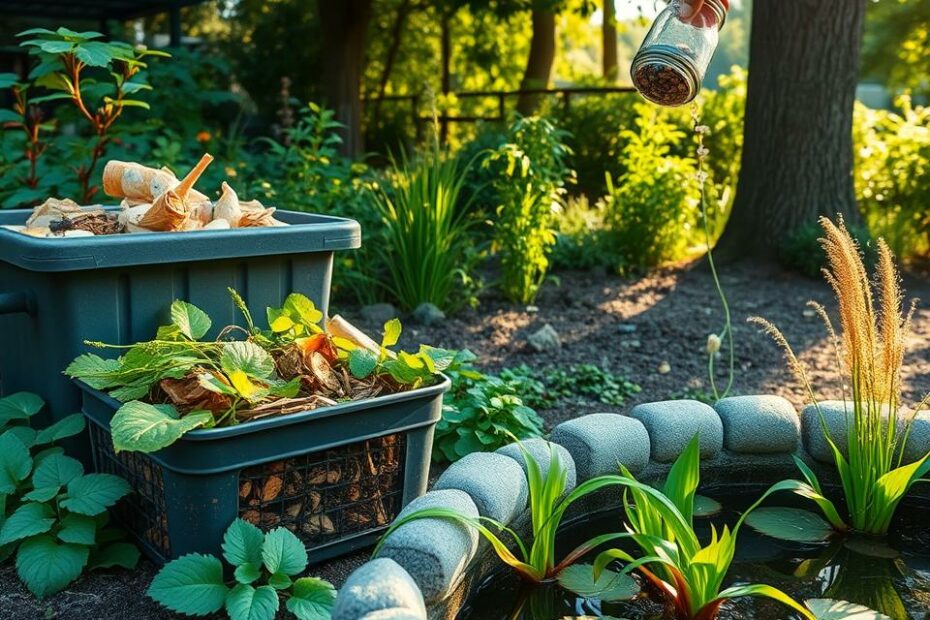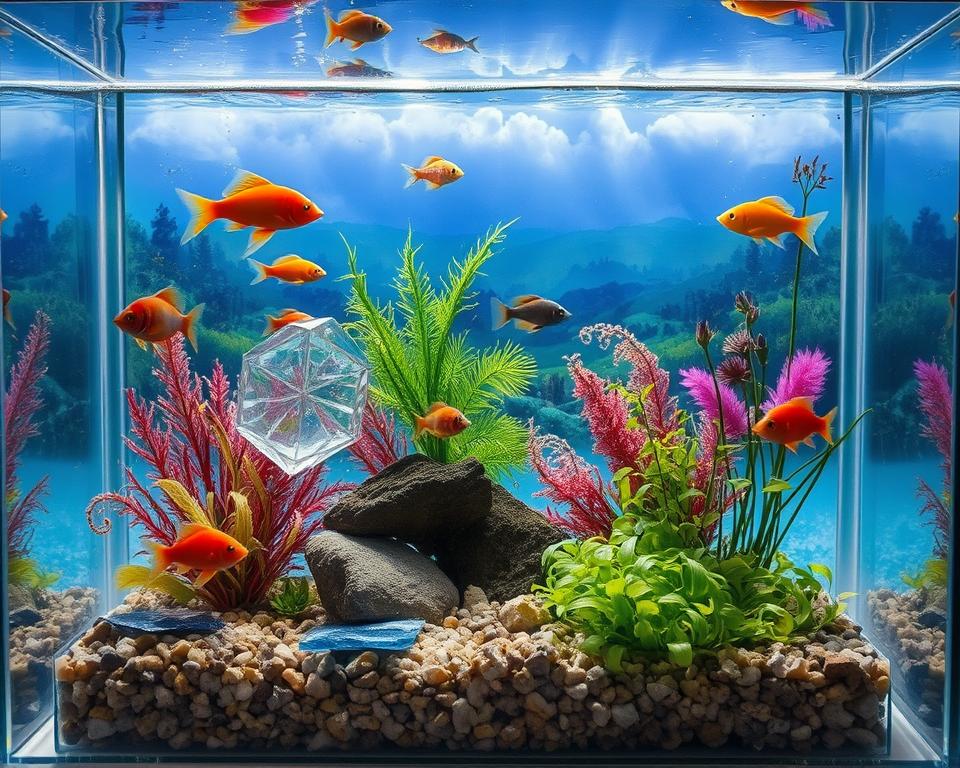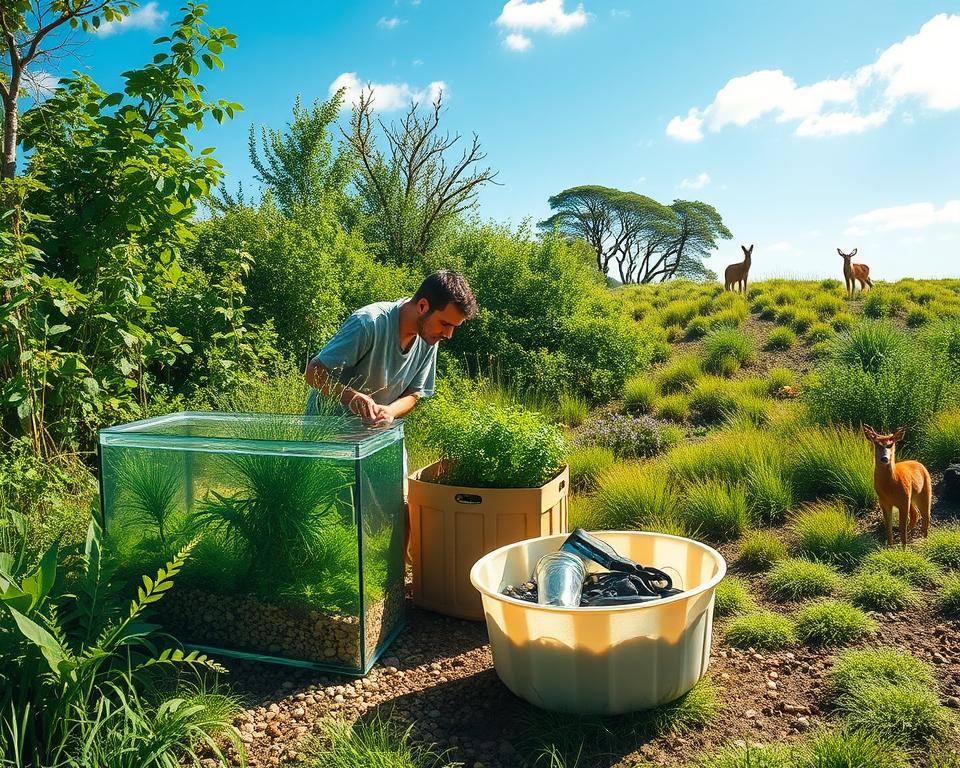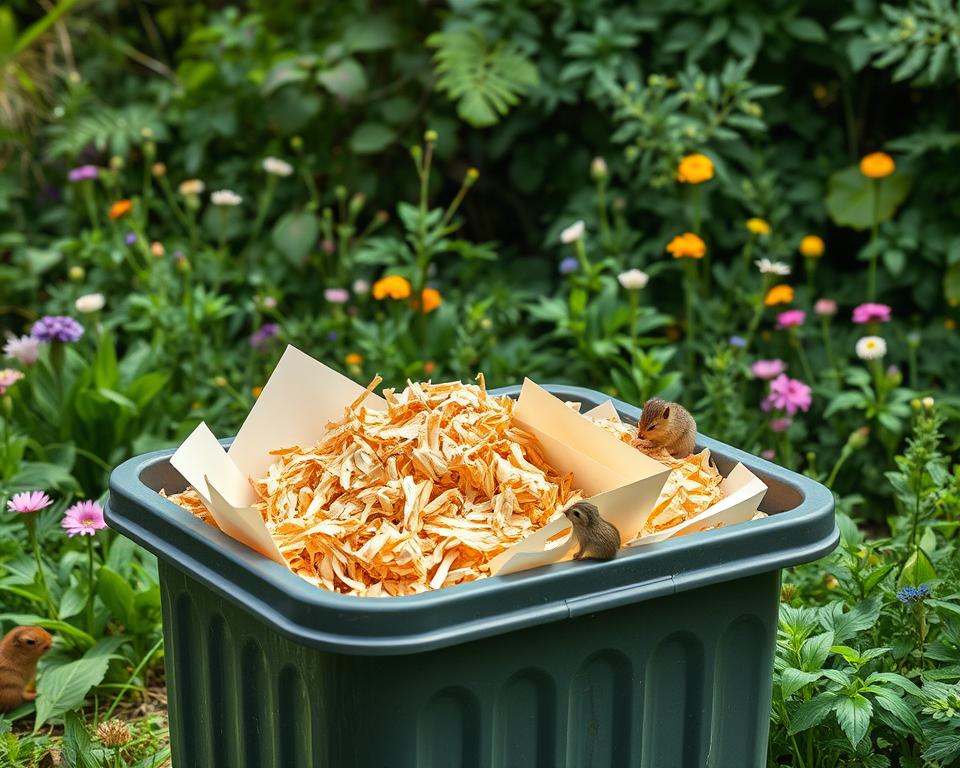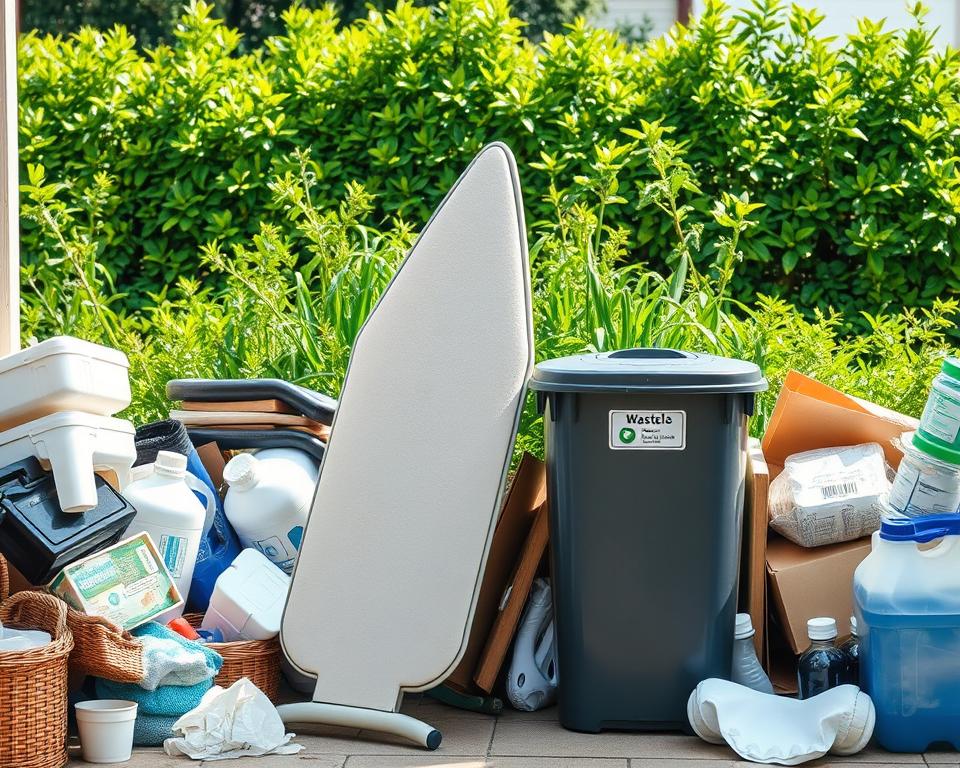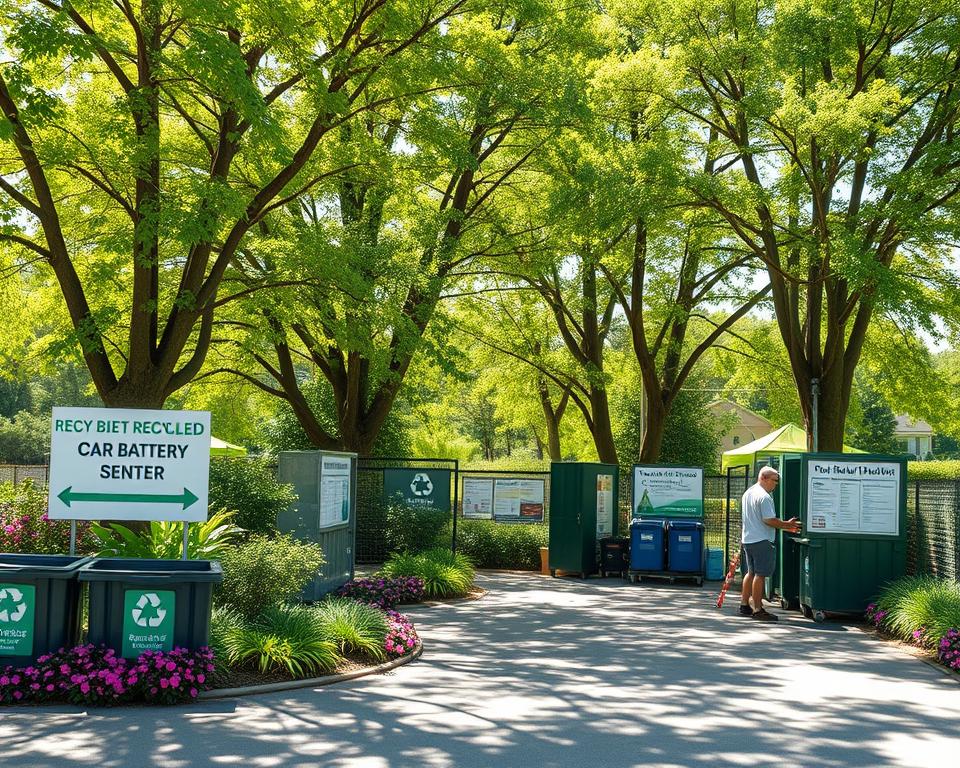Did you know nearly 30% of aquarium owners want to recycle their old tanks? But, many find it hard to dispose of them properly. This article will show you how to get rid of your aquarium safely and with care for the environment. You can try DIY methods, use professional services, or even sell or donate your equipment. Let’s explore the best ways to dispose of your aquarium!
Key Takeaways
- DIY disposal can save money but typically doesn’t yield financial return like selling or donating.
- Hiring junk removal services assures safe disposal but may be costly for larger aquariums.
- Donating or selling your aquarium can provide extra income without the expense of a junk service.
- Disassembly aids in efficient recycling by sorting glass, plastic, and electronics.
- Safety is crucial during disposal; using gloves and goggles protects against potential hazards.
Understanding the Need to Dispose of Aquarium
Many homeowners need to get rid of their aquariums for different reasons. These include moving, changes in lifestyle, and trouble with upkeep. An ignored aquarium can be ugly, cause bad smells, and more. It’s important to dispose of it properly to protect the environment.
In the U.S., about 7.6 million tons of glass ended up in landfills in 2018. Glass tanks take about 1 million years to break down. By choosing the right way to get rid of them, we can help reduce waste and ease the burden on landfills.
Turning old fish tanks into something new is a green way to reduce landfill size. An old tank can become a learning tool in schools or a cool coffee table. It can also be part of an aquaponics system, which saves water and cuts down on chemical use.
By donating or selling old fish tanks that are still in good shape, we can help the planet. Local groups often help us find the best ways to dispose of them, making sure both the equipment and nature stay healthy.
| Reason for Removal | Impact of Poor Disposal | Responsible Disposal Options |
|---|---|---|
| Relocation | Increased landfill waste | Donate or sell the tank |
| Lifestyle Changes | Environmental harm | Repurpose into a new project |
| Maintenance Difficulties | Odor and bacteria growth | Use professional disposal services |
Options for Aquarium Removal
Homeowners have many choices for aquarium removal. Knowing these options helps ensure the aquarium is disposed of properly. Some choose DIY methods, which can save money but require a lot of work. For example, offering the aquarium for free on local forums can find someone who wants to fix or reuse it.
Many people have found success with this method. In fact, 30% of forum users recommend it.
Others prefer to hire professionals. Companies like LoadUp offer aquarium removal starting at $89. This is cheaper than many junk removal services, with prices 20-30% lower. They provide in-home pickups, curbside pickups, and flexible scheduling, making the process easy.
Donating or selling the aquarium is another option. Contacting local pet stores like Petco or Pet Supermarket can help find a new home for the aquarium. This is good for the environment and ensures the aquarium is disposed of responsibly. You can also donate or recycle aquarium gear like pumps, filters, and lights.
Some might choose traditional disposal methods. This includes coordinating with local municipalities for curbside pickups, which 40% of users recommend. Others might take the aquarium to a landfill or dump, as 20% suggest. For those who want hassle-free removal, services like 1-800-GOT-JUNK are available.
How to Get Rid of Fish Tank: DIY Methods
Deciding to dismantle your aquarium yourself can be rewarding and cost-effective. Knowing the steps for DIY aquarium disposal is key for a successful process. This guide will help you get rid of your fish tank setup efficiently and responsibly.
Step-by-Step Guide to DIY Aquarium Disposal
- Relocate Fish and Aquatic Plants: Begin by moving your fish and plants to a temporary tank. This keeps them safe while you work.
- Drain the Aquarium: Carefully remove all water from the tank. A siphon vacuum helps, especially when removing up to 25% of dirty water during cleaning.
- Remove Substrate and Decorations: Take out gravel, rocks, and decorations. Think about eco-friendly disposal, like giving away sand on Craigslist or making a backyard sandbox.
- Dismantle the Tank: After emptying, carefully take apart the tank. Use algae scraper pads or diluted bleach to clean surfaces.
- Sort Recyclable Materials: Separate glass and plastic for recycling. Check local recycling guidelines to ensure eco-friendliness.
Benefits and Challenges of DIY Disposal
DIY aquarium disposal has many advantages. It saves money and lets you have a personal touch. Many people enjoy the control and knowing their waste is handled right.
However, DIY disposal comes with challenges. It can be hard work, requiring physical effort and time. You need to know how to dispose properly to avoid harming the environment. Safety is crucial, especially when handling glass or sharp objects.
Professional Aquarium Disposal Services
Getting rid of an aquarium can be tough. The tank’s weight and setup complexity might make you think about professional help. This choice makes the process easier and ensures it’s done safely. Many people find it saves them a lot of time and effort.
When to Consider Hiring Professionals
Deciding if you need professionals for your aquarium is key. Here are some times when it’s a good idea:
- Large tanks are hard to move by yourself.
- There’s worry about the environment.
- You’re short on time for DIY.
- There are safety concerns with heavy or hazardous parts.
Most people, 78%, choose pros for their eco-friendly aquarium disposal. They also like these services for getting rid of clutter and trash. This shows there’s a big need for green and efficient solutions.
What to Expect from a Junk Removal Service
When you hire a junk removal service, expect a detailed approach. They’ll check out the situation, sort materials, and dispose of them properly. Aquarium removals start at $89, which is 20%-30% cheaper than others. Companies like LoadUp use eco-friendly methods, supporting green efforts.
Many like the convenience of in-home aquarium pick-up. It takes care of all the heavy lifting. Curbside pickups save $5, which is another plus. So, 86% of clients look for companies that care about the environment, especially with hazardous materials.
Donating or Selling Your Old Aquarium
Donating or selling your old aquarium can help both you and the new owner. It’s a chance to give your aquarium a new home. Local aquarium clubs, schools, and charities often take these donations.
This helps the community and saves resources. It’s a win-win for everyone involved.
Finding Suitable Buyers or Donation Centers
Animal shelters and community centers are great places to donate aquarium items. They use these donations for educational programs. This way, you help others and reduce waste.
Waste from glass aquariums can take over a million years to break down. Finding local aquarium donation centers makes the process easier.
Online Platforms for Selling Aquarium Equipment
Online marketplaces make selling aquarium equipment simple. Sites like Craigslist and social media are great for listing your aquarium. Selling can take time, but it’s worth it for the financial gain and the joy of rehoming your tank.
Joining local fishkeeping communities online can help you sell faster. Many sellers find they get 20% to 30% more than junk removal services.
Eco-Friendly Ways to Recycle Aquarium Components
Recycling aquarium parts is key to a greener future and less waste in landfills. Knowing what can be recycled helps us dispose of things right. This way, we all play a part in keeping our planet clean.
Identifying Recyclable Materials
Here are some recyclable materials from aquariums:
- Glass from aquarium tanks
- Plastic parts like filters and tubing
- Metal parts, including frames and hardware
- Electronic items like lighting systems and pumps
- Used batteries from aquarium equipment
It’s important not to throw away items like aquatic plants in local sewers. This can harm the environment, like the Hydrocotyle plant did in the Netherlands.
Local Recycling Facilities and Guidelines
Looking up aquarium recycling facilities in your area helps you know how to dispose of aquarium stuff. Some places have special programs for things like electronic filters and lights. In Germany, for example, old electronics must go to recycling centers under the Electronic Equipment Act (ElektroG).
Other tips include:
- Don’t throw batteries in trash; find the right place to dispose of them.
- Look for public spots to drop off used aquarium lights to avoid throwing them away wrong.
- Make sure to get rid of calibration liquids and water test solutions the right way.
By recycling responsibly, we help the planet and join community efforts to cut down pollution and save resources. Taking part in local recycling events can make a big difference and help us achieve our goals.
Safety Precautions while Disposing Fish Tank
Getting rid of an aquarium can be risky. Broken glass, heavy parts, and cleaning chemicals are hazards. To stay safe, follow the right steps for disposal.
Essential Safety Gear and Procedures
Wearing the right safety gear is key. Here are some must-haves and steps to take:
- Gloves: Protect hands from sharp edges and chemicals.
- Goggles: Shield eyes from potential splashes or debris.
- Mask: Prevent inhalation of dust or fumes from cleaning agents.
Make sure your workspace is well-ventilated. This helps avoid breathing in harmful stuff. Always clean up safely when dealing with dangerous materials.
Dealing with Sharp Objects and Hazards
When taking apart the aquarium, you might find sharp things. Here are some tips for staying safe:
- Avoid using bare hands when handling broken glass or sharp decorations.
- Safely store all hazardous materials in appropriate containers until disposal.
- Double-check your cleaning agents and ensure they are compatible and stored safely.
By following these safety tips, you can avoid risks and make the disposal process easier. With the right gear and careful handling, you can recycle or dispose of your tank safely.
| Hazardous Material | Accepted at Special Waste Sites |
|---|---|
| Aerosol Cans (full) | No |
| Antifreeze | Yes |
| Bleach or Other Corrosive Cleaners | Yes |
| Electronics | Yes |
| Fluorescent Light Bulbs (less than 4 feet) | Yes |
| Gasoline or Heating Oil | Yes |
| Medical Waste | Yes |
| Pneumatic Tanks (Gas, Helium, Oxygen, or Propane) | Yes |
| Tires (up to 4) | Yes |
Repurposing Your Old Fish Tank
Turning an old aquarium into something new is a great way to make your home better and help the planet. Instead of throwing it away, you can give it a new life. This not only makes your space look good but also helps the environment. Glass, for example, takes over a million years to break down in landfills.
Creative Ideas for Upcycling Aquariums
There are many fun ways to reuse an old aquarium:
- Coffee or Side Table: Make a cool table out of a fish tank. It’s a unique addition to your home.
- Herb Garden: Turn it into a garden for herbs. It needs some care, like food for the plants.
- Aquaponics System: Mix fish and plants in a special way. It’s good for the planet and gives you food.
- Decorative Terrarium: Fill it with plants and rocks. It’s a beautiful decoration for any room.
Transforming Your Aquarium into a Terrarium
Changing your aquarium into a terrarium is a great idea. It brings life to an old tank. You can plant different plants that make the air cleaner and look nice.
Using an old fish tank again is good for the planet and teaches kids about recycling. It’s a fun way to learn about taking care of the environment.
| Upcycling Project | Description | Benefits |
|---|---|---|
| Coffee Table | Turn a fish tank into a stylish table. | Unique design and functionality. |
| Herb Garden | Plant herbs inside the tank. | Fresh produce and improved air quality. |
| Aquaponics System | Combine fish and plant growth. | Less maintenance and water efficiency. |
| Decorative Terrarium | Fill with decorative plants and stones. | Aesthetic enhancement of living spaces. |
How to Properly Dispose of Aquarium Components
Properly getting rid of aquarium parts means sorting them right. It’s key to tell recyclable from non-recyclable stuff. Safe ways to dispose help the planet and follow local rules. If we don’t dispose right, bad stuff can harm nature.
Disposing of Non-Recyclable Materials
For non-recyclable items like broken glass and some plastics, we must dispose carefully. Don’t just throw them away. Reach out to local waste services for advice. Broken glass needs special care; wrap it in paper or bubble wrap to avoid cuts.
Steps for Safe Disposal of Fish Tank Parts
Here’s how to safely get rid of fish tank parts:
- Identify all materials: Know which parts can be recycled and which can’t.
- Clean components: Clean everything before you throw it away to help recycling.
- Wrap sharp objects: Use something soft to cover sharp things to avoid cuts.
- Separate materials: Take apart things like filters into plastic and metal for recycling.
- Local resources: Find recycling centers near you to make sure everything is recycled right.
Knowing how to dispose of aquarium waste properly is important. Working with local recycling centers helps keep our planet safe. It stops damage from bad disposal.
Community Initiatives for Aquarium Disposal
Getting involved in aquarium disposal efforts helps us care for our planet. Local events teach us how to manage waste properly. They show us how to recycle and keep our environment clean.
Local Events for Responsible Waste Management
Going to waste management events is a great way to learn and help. You might find:
- Workshops on how to dispose of aquarium parts right.
- Community clean-up days to pick up trash near water.
- Events that teach about the harm of bad waste disposal on sea life.
Aquariums and green groups host these events. They aim to teach us and help save our planet. By joining, you make new friends and learn a lot about caring for our world.
How to Engage with Environmental Groups
Working with green groups helps you do more for our planet. They teach us about waste management and offer tips. Here’s how to get involved:
- Go to meetings or events by green groups.
- Help out with clean-ups or teaching others.
- Join online groups or social media for green topics.
By joining these groups, you help spread the word about proper aquarium disposal. You also help protect our oceans and seas.
| Environmental Engagement Activity | Description | Impact |
|---|---|---|
| Community Clean-Up | Volunteers clean up local parks or water bodies. | Less litter, more community spirit. |
| Workshops | Learn about recycling aquarium stuff. | More knowledge, better habits. |
| Awareness Campaigns | Teaching the community about waste. | More eco-awareness, better choices. |
Environmental Impact of improper Aquarium Disposal
Improperly getting rid of aquariums can really harm the environment. When we dump fish tanks and parts without care, they often end up in landfills. This waste stays for millions of years and can spread harmful species.
This messes up local ecosystems, hurting native species and reducing biodiversity.
Consequences of Landfill Waste
Throwing aquarium stuff in landfills is bad for the planet. Non-biodegradable items like plastic turn into pollution. Organic waste can pollute soil and water too.
Releasing fish or plants into the wild can harm local wildlife. For example, goldfish and red-eared sliders in urban ponds overcrowd and disrupt ecosystems.
Benefits of Sustainable Disposal Practices
Choosing sustainable disposal has many benefits. Recycling and repurposing aquarium parts can save resources and cut down pollution. By picking eco-friendly disposal, we help keep ecosystems healthy.
Donating or recycling aquarium items helps reduce landfill waste. It also helps protect native habitats.
| Disposal Method | Environmental Impact | Sustainable Benefits |
|---|---|---|
| Landfill Disposal | Contributes to pollution and habitat destruction | None |
| Recycling | Reduces waste and pollution | Conserves resources and energy |
| Donation | Prevents unnecessary waste | Promotes community engagement and resource sharing |
| Repurposing | Minimizes landfill impact | Encourages creativity and innovation |
By making smart disposal choices, we protect our environment. We also support sustainable practices for a greener planet.
Conclusion
Homeowners looking to get rid of their aquariums have many eco-friendly options. They can try DIY methods or hire professionals for aquarium removal. Donating or selling your old aquarium also helps and gives it a new purpose.
Recycling and upcycling are great for aquarium parts. By finding places to recycle, we help the environment and ourselves. These actions make our community cleaner and protect the planet for the future.
Choosing sustainable disposal methods is key to reducing waste. By exploring different ways to get rid of aquariums, we improve our lives and the planet. Our decisions today can lead to a greener tomorrow.
FAQ
What are eco-friendly methods to dispose of my aquarium?
You can dispose of your aquarium in eco-friendly ways. Options include DIY, hiring pros, donating, or recycling parts. Each method helps the environment and is responsible.
How can I safely dismantle my fish tank?
First, move fish and plants to a temporary tank. Then, empty the aquarium carefully. Wear gloves and goggles for safety. Sort recyclables like glass and plastic, and follow local disposal rules.
Are there recycling programs specifically for aquarium materials?
Yes, many recycling centers accept aquarium materials. Look for programs for glass, plastic, and metal. Check local guidelines for disposal.
How do I know if my old aquarium can be donated?
Contact local aquarium clubs, schools, or charities to donate. They often take used tanks. Make sure the tank is in good shape before donating.
What safety precautions should I take during aquarium disposal?
Wear gloves, goggles, and work in a well-ventilated area. Be careful with sharp glass and hazardous materials.
Can I sell my aquarium online, and what platforms should I use?
Yes, you can sell online on Craigslist, Facebook Marketplace, or aquarium forums. Provide clear descriptions and photos to attract buyers.
What are some creative ways to repurpose my old fish tank?
You can turn your tank into a terrarium, aquaponic system, or planter. These ideas reduce waste and add beauty to your home.
What should I do with non-recyclable aquarium components?
Dispose of non-recyclable parts according to local waste guidelines. Don’t throw them in regular trash to avoid harming the environment.
How can I find professional aquarium removal services?
Search online, read reviews, and check local directories for services. Choose ones that offer safe and eco-friendly disposal.
What are the environmental consequences of improper aquarium disposal?
Improper disposal can harm the environment, adding to landfill waste. Sustainable disposal practices reduce these impacts and conserve resources.
